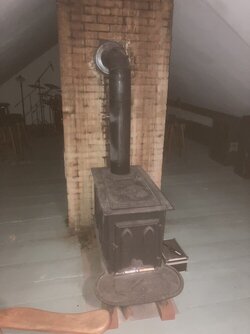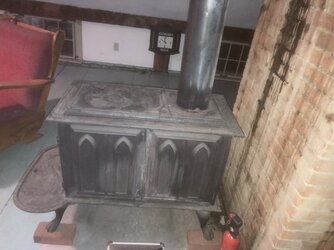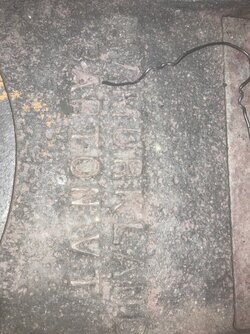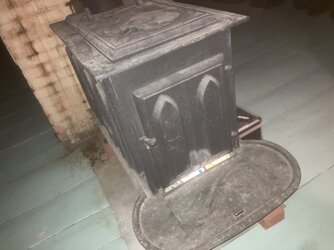Antique stove from Barton, Vermont ??
- Thread starter N.E.K. - D.D.S.
- Start date
-
Active since 1995, Hearth.com is THE place on the internet for free information and advice about wood stoves, pellet stoves and other energy saving equipment.
We strive to provide opinions, articles, discussions and history related to Hearth Products and in a more general sense, energy issues.
We promote the EFFICIENT, RESPONSIBLE, CLEAN and SAFE use of all fuels, whether renewable or fossil.
You are using an out of date browser. It may not display this or other websites correctly.
You should upgrade or use an alternative browser.
You should upgrade or use an alternative browser.
Interesting that the town was big enough to support a foundry. That design was made all over the US. Portland Stove Foundry was a big producer in New England. I wonder if it was poured elsewhere and made for a specific vendor. Those types of stoves were used all over including logging camps, I run into bit and pieces of them when hiking in the whites. They rarely are air tight and intended to put out a lot of heat in short period but without any baffles in them a lot of the heat goes right up the stack which is sometimes a benefit with green wood as the stack temp stays high enough that the smoke does not condense.
I had one in my basement when I first built my house and after a weekend of burning my chimney would be quite warm on my second floor, I switched to a Fisher clone and the stack was less warm and when I swapped to my Defiant, the chimney was even cooler. With my boiler its rarely warm except in very cold stretches
I had one in my basement when I first built my house and after a weekend of burning my chimney would be quite warm on my second floor, I switched to a Fisher clone and the stack was less warm and when I swapped to my Defiant, the chimney was even cooler. With my boiler its rarely warm except in very cold stretches
They rarely are air tight and intended to put out a lot of heat in short period but without any baffles in them a lot of the heat goes right up the stack which is sometimes a benefit with green wood as the stack temp stays high enough that the smoke does not condense
High heat in a short amount of time is exactly what I need in this particular space. There is no other heat source and it is normally left cold. I would just run the stove occasionally when hanging out in there.... and then let it burn out.
I have a similar unsealed (by design) morning stove in the kitchen, which is much smaller. My experience with it is as you say: High heat, quick heat, tolerates green wood, functions amazingly well with good wood, the stove pipe gets hot, not much buildup/creosote. It certainly does eat wood quickly.... but it is puts out a corresponding amount of heat.
The big attic stove (the one in the photo) goes into an unlined chimney. That would probably be a disaster with a modern stove, but I have heard that the stove used to function well. I thought of doing a round liner, but I wonder if it would increase performance, if there are not draft issues to begin with.
A liner the same size as stove outlet would increase efficiency and insulation around it (minimum 1 inch blanket) is needed for safety. (Measuring inside area vs. exterior will give wall thickness. This needs to be 12 inches solid masonry if no clearance to framing members) Notice the fluid that leaked out and ran down the outside of chimney. The inside is much worse.High heat in a short amount of time is exactly what I need in this particular space. There is no other heat source and it is normally left cold. I would just run the stove occasionally when hanging out in there.... and then let it burn out.
I have a similar unsealed (by design) morning stove in the kitchen, which is much smaller. My experience with it is as you say: High heat, quick heat, tolerates green wood, functions amazingly well with good wood, the stove pipe gets hot, not much buildup/creosote. It certainly does eat wood quickly.... but it is puts out a corresponding amount of heat.
The big attic stove (the one in the photo) goes into an unlined chimney. That would probably be a disaster with a modern stove, but I have heard that the stove used to function well. I thought of doing a round liner, but I wonder if it would increase performance, if there are not draft issues to begin with.
The issue is the hot exhaust gasses are allowed to expand in the larger area. This drops them below condensing point of 250*f. You need to measure the actual flue area this is using. That’s why it is against code to use a flue 3 times the size as stove outlet. Then you will know how much expansion and cooling you have.
The fluid is pyroligeneous acid. Primarily methanol (wood alcohol) and acetic acid. In fluid form, from condensing of water vapor from combustion, mixing with smoke particles, this is harmless. When allowed to bake in chimney it becomes creosote. If this ignites in that chimney with no liner, probably less than required clearance to framing members, it will ignite easily since the heat from that chimney over the years has lowered the ignition temperature of material around it.
Last edited:
Yes I see what you mean about cooling that occurs by going into such a large chimney. The stove pipe enters the chimney almost at the roof line... so I am trying to justify it in my head that way. The smoke is not travelling very far. I have not tried the stove. The stains are from previous owners.A liner the same size as stove outlet would increase efficiency and insulation around it (minimum 1 inch blanket) is needed for safety. (Measuring inside area vs. exterior will give wall thickness. This needs to be 12 inches solid masonry if no clearance to framing members) Notice the fluid that leaked out and ran down the outside of chimney. The inside is much worse.
The issue is the hot exhaust gasses are allowed to expand in the larger area. This drops them below condensing point of 250*f. You need to measure the actual flue area this is using. That’s why it is against code to use a flue 3 times the size as stove outlet. Then you will know how much expansion and cooling you have.
The fluid is pyroligeneous acid. Primarily methanol (wood alcohol) and acetic acid. In fluid form, from condensing of water vapor from combustion, mixing with smoke particles, this is harmless. When allowed to bake in chimney it becomes creosote. If this ignites in that chimney with no liner, probably less than required clearance to framing members, it will ignite easily since the heat from that chimney over the years has lowered the ignition temperature of material around it.
I am not sure if I want to do a liner (looks better, and frees up the chimney for other uses) or an insulated metal chimney pipe straight out of the roof. It is a short distance. My hesitation involves cutting a hole in the metal roof, which may be more difficult.
Perhaps I will do a small monitored fire in it to test it. I will then at least have a frame of reference for how it performs when I put the round liner (or chimney) on it. I will feel much better mentally if it ends up performing better.... or at least the same, while being safer.
Last edited:
Oops, I meant to say that the liner looks better, but a separate insulated metal chimney pipe through the room would free up the masonry chimney for other uses (fireplace and brick oven). In the past they had everything dumping into it. It is not as bad as you might imagine. Also, I can access all of the masonry from the outside. So I could repoint or repair any bricks. I did a test and not finding any smoke leakage. I am going to do some more measurements with instruments.Yes I see what you mean about cooling that occurs by going into such a large chimney. The stove pipe enters the chimney almost at the roof line... so I am trying to justify it in my head that way. The smoke is not travelling very far. I have not tried the stove. The stains are from previous owners.
I am not sure if I want to do a liner (looks better, and frees up the chimney for other uses) or an insulated metal chimney pipe straight out of the roof. It is a short distance. My hesitation involves cutting a hole in the metal roof, which may be more difficult.
Perhaps I will do a small monitored fire in it to test it. I will then at least have a frame of reference for how it performs when I put the round liner (or chimney) on it. I will feel much better mentally if it ends up performing better.... or at least the same, while being safer.
Still, this stove needs either a liner, or to go out the roof (that may be the absolute best as far as function). I just don't know how to deal with the metal roof cutting and preventing water leakage.
D. Hermit
Feeling the Heat
Yes there were stoves in Barton, I have seen a few of these. Barton is the next town over and ive been meaning to get over to the town clerk and do some digging. Ill update the thread with what I learn.
Sawset
Minister of Fire
Does Barton VT have a history of a foundry?I wonder if it was poured elsewhere and made for a specific vendor.
Near here is Iron Ridge and Mayville, WI. Interesting history of iron ore, a stove, and a town.

Mayville Iron Parlor Stove | Wisconsin Historical Society
Gothic revival parlor stove made of iron ore from Mayville, Wisconsin, 1846. (Museum object #1999.141.1)
all night moe
Minister of Fire
Love them Elm stoves in your avatar.Yes there were stoves in Barton, I have seen a few of these. Barton is the next town over and ive been meaning to get over to the town clerk and do some digging. Ill update the thread with what I learn.
Wish I could find me one.
His stoves are okay, but I have a more efficient setup in my avitar.Love them Elm stoves in your avatar.
Wish I could find me one.
Cool.Does Barton VT have a history of a foundry?
Near here is Iron Ridge and Mayville, WI. Interesting history of iron ore, a stove, and a town.

Mayville Iron Parlor Stove | Wisconsin Historical Society
Gothic revival parlor stove made of iron ore from Mayville, Wisconsin, 1846. (Museum object #1999.141.1)www.wisconsinhistory.org
Any idea how old my stove (in original post) might be?
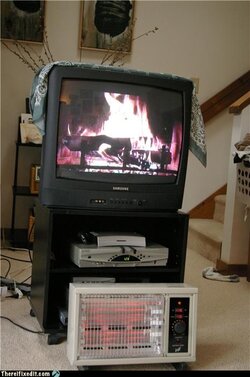
all night moe
Minister of Fire
Yes there were stoves in Barton, I have seen a few of these. Barton is the next town over and ive been meaning to get over to the town clerk and do some digging. Ill update the thread with what I learn.
The avatar.... in my well learned opinion is circa 1990.That's some lazy heat there.
i couldn't guess the age of your stove in question.
As for the iron stove... how about that hearth! Nice, eh?
I can build you one like that for a good price.
So yeah, that is how it was when I moved in.
What would you guys put underneath the stove? My kitchen stove doesn't have much heat under it, and it has significant legs, so it seems to be more for ember protection than heat conduction (though correct me if I am wrong). This attic stove seems it will be similar.
I don't exactly mind the metal in that particular room (it is meant to be a severely casual room). . I have old bricks around here, and we have fixed three of our other hearths, so I could make a brick hearth also. Although it is heavy. I wonder about support by the floor.
all night moe
Minister of Fire
For the iron stove, since it has such tall legs, a sheet of cement board would catch any runaway embers. Although not up to code, it is light weight. When you clarify the integrity of the structure, you can build a better hearth reusing the cement board as a backer under your brick or stone.What would you guys put underneath the stove?
My stove is heavy as is. I built a platform of salvaged 2x4s, (old school 1 3/4x 3 3/4), and 1'' planks with a sheet of mason board on top.
My stave has short legs. It sits on 5'' legs and weighs 450-500lbs. I've been underneath in the crawlspace. The floor joists are a true 3x10.
These old houses are nice in effect that the timber came from the land it sits on. The wall sheathing is also 1'' so I'm sure the floor decking is equal or greater. Then there is the finish planked floors on top of that. I have to move the stove out of this room for remoldeling at some point. This room is still in plaster walls with zero insulation. My hearth/ platform is floating on top. I plan for blue stone for a finished hearth with field stone surround.
all night moe
Minister of Fire
Ahh, you're the fella advertising "Elm stoves wanted" on CL?I restore many Elms a year. Reach out either on here or over on my Shop page and I might be able to find you one.
D. Hermit
Feeling the Heat
That would be me yes, well im the main one, I see other people do it sometimes as well. But I get the most through word of mouth and people just calling or emailing my shop.Ahh, you're the fella advertising "Elm stoves wanted" on CL?
They have been in their current positions for a long long time.For the iron stove, since it has such tall legs, a sheet of cement board would catch any runaway embers. Although not up to code, it is light weight. When you clarify the integrity of the structure, you can build a better hearth reusing the cement board as a backer under your brick or stone.
My stove is heavy as is. I built a platform of salvaged 2x4s, (old school 1 3/4x 3 3/4), and 1'' planks with a sheet of mason board on top.
My stave has short legs. It sits on 5'' legs and weighs 450-500lbs. I've been underneath in the crawlspace. The floor joists are a true 3x10.
These old houses are nice in effect that the timber came from the land it sits on. The wall sheathing is also 1'' so I'm sure the floor decking is equal or greater. Then there is the finish planked floors on top of that. I have to move the stove out of this room for remoldeling at some point. This room is still in plaster walls with zero insulation. My hearth/ platform is floating on top. I plan for blue stone for a finished hearth with field stone surround.
Do these type of old stoves typically require anything other than ember protection? It just never feels all that hot to the touch under the kitchen stove.
all night moe
Minister of Fire
The legs are giving you plenty of air space ..... it may not be up to code but the mason board will keep any embers from rolling out and hitting the floor, during stove refills.They have been in their current positions for a long long time.
Do these type of old stoves typically require anything other than ember protection? It just never feels all that hot to the touch under the kitchen stove.
Similar threads
- Replies
- 0
- Views
- 750
- Replies
- 4
- Views
- 945
- Replies
- 2
- Views
- 494


